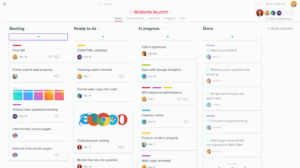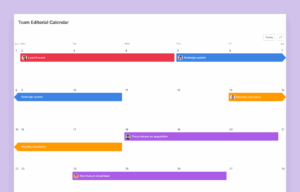After days, weeks, or even months of searching, you finally found the perfect project management software for your company: Asana. You were so excited to get started with your shiny new tool and dive right in, head first.
But once you got inside the program, you realized you had no idea what you were doing. There were so many buttons and features and available options. How could anyone be expected to make sense of it all? If this sounds at all familiar, don’t worry!
In this article, we’ll break down Asana and show you how to use it to boost team productivity. We’ll cover a few noteworthy features and even share five Asana best practices. By the time you’re finished reading, you’ll be a veritable Asana expert.
What Is Asana?

Asana is a popular project management software that allows users to easily organize, track, and manage both business and personal tasks. The tool was created by former Facebook and Google employees and officially launched in 2012.
Since that time, Asana has gained many adoring fans including professionals at well-known organizations like NASA, Salesforce, and Comcast. Not bad!
3 Noteworthy Asana Features

Source: Asana
Asana comes loaded with many helpful features. We won’t list all of them here — you can always visit the company’s website to read up on all the software’s capabilities. Instead, we’ll focus on specific Asana features that help users get more done in less time.
If you’re wondering how to use Asana for productivity, you’ve come to the right place! Here are our three favorite productivity-boosting Asana features:
Project Views
Asana is flexible and allows its users to choose how they view their projects. Here’s a quick rundown of all four possible configurations:
- Boards View: If you’re big on visuals, you’ll love Asana’s Boards View (shown above). This view operates as a Kanban board (Trello users will recognize this approach to project management!) and allows users to segment large projects into stages, represented by vertical columns, and individual tasks, represented by digital cards.
For example, the process of writing blog posts for your company’s website could be divided into four stages or columns: “Ideas,” “Writing,” “Editing,” and “Published.” Individual tasks (cards), in this instance, would be the blog post ideas you plan to write.
When a post goes from the “Ideas” stage to the “Writing” stage, Asana will let you move the task from one column to the next, making it incredibly easy to track project progress.
- List View: Projects in Asana can also be viewed as standard to-do lists. This view is perfect for those looking to get the full picture of the current project they’re managing. In one screen, you’ll be able to see each and every task that needs to be completed.
You’ll also be able to see, at a glance, when every task is due, how far along each task is, and which team member is in charge of completing them.
Once a task has been clicked on, a full-screen view will appear containing more details — details such as in-depth task directions, employee chat boxes, text or image attachments, and more. What your individual tasks include is up to you.
- Timeline View: Next, we have the Timeline View, which allows users to map out their projects on a timeline and view the relationship between each of them.
This view is perfect for complex projects that contain a lot of moving parts. What if, for example, you map out an entire project that contains dozens of tasks that need to be completed, of which, some need to be finished before others can begin?
Asana allows users to easily set up dependencies in the Timeline view by clicking and dragging the connector icon from one task to another. If dependent tasks ever overlap, Asana will notify its users of the potential conflict.
- Calendar View: Finally, there’s the Calendar View; a traditional monthly calendar that displays tasks on the day (or days) they should be completed. As described previously, tasks on the Calendar can be clicked and a larger screen containing more detailed information will appear.
For every view, Asana allows its users to color code their tasks based on their own preferences. For instance, specific kinds of tasks, like marketing and sales tasks, can be given certain colors.
This feature is especially helpful in the Calendar View where the tasks that need to be completed on specific days of the week overlap. Color coding each task helps distinguish them from the others.
We should note that users can view their projects in any of the four views listed above. They just need to select the view that suits their needs and Asana will adjust their screen to suit.
In-App Communication
We mentioned it briefly, but Asana’s in-app communication features are powerful and deserve a closer examination. Let’s take a look:
Effectively managing projects often requires a team of skilled individuals. And the only way to get multiple individuals to work together efficiently is to provide easy and convenient ways for them to communicate. This is where Asana’s in-app communication feature really shines.
Rather than having to pull up a secondary tool such as Slack or good, old fashioned email, Asana users can save time by conversing directly inside this project management tool.
Every task includes a chat area where users can share ideas, send links and attachments, like comments from colleagues, and more. Users can also tag other team members by putting the @ symbol before their username and bring them into the conversation when the need arises.
Proven Templates
Lastly, the templates that come with Asana really help this project management software stand out from the many others on the market. It will also help you get more done in less time, especially if you aren’t very experienced at managing projects.
No matter what department you work in — Marketing, Design, HR, IT — Asana has a template that will help you manage the common projects you’re asked to complete on a daily basis.
Let’s dive into a Marketing template to explain how this feature works. If we wanted to plan an event, we would select the “Event Planning” template that’s preloaded with important event-planning tasks and milestones to be completed.
All we’d have to do next is customize the template so that it only includes the tasks we need to finish, has the correct due dates, assign team members to each task, and then follow the template until the day of our event. It’s incredibly convenient!
We should also mention that you can create your own custom templates inside Asana. If you manage the same kinds of projects over and over again, don’t reinvent the wheel every time. Simply create a custom template that includes the tasks and milestones you always need to complete and then fire it up each time a new project starts.
For those looking to boost project management productivity, Asana’s template feature is a must-have and we definitely recommend using it!
5 Asana Best Practices

Source: Asana
If you really want to learn how to use this project management software effectively, take heed to the following best practices. These tips and tricks for Asana will allow you to use the tool to its full capacity and boost your team’s productivity to new heights.
1. Get Comfortable With “My Tasks”
“My Tasks” is, unsurprisingly, where all of your personal tasks reside. If a specific job has been assigned to you (or you’ve assigned it to yourself) in Asana, you’ll find it in the My Tasks section.
Don’t waste time culling through company-wide project Calendar and Timeline views searching for “that one task” you’re pretty sure you need to get done today. Simply make your way to My Tasks and view your workload for the day, week, month, etc.
This is one of our simplest Asana tips, but it will definitely help you improve your productivity levels once you make it a part of your regular workflow.
2. Focus On Team Collaboration
Asana works because it provides users with an intuitive platform to collaborate on projects and ensure work gets done on time and on budget. If you don’t use the collaboration features that Asana offers, you’re not getting the most out of the tool.
So don’t be afraid to @mention co-workers, chat with them in-app about the projects you’re working on, send links and attachments, and otherwise use Asana to connect with your team.
As mentioned previously, communicating with your employees and/or colleagues inside Asana will save you from switching back and forth between multiple apps — a practice that absolutely kills productivity for many office workers.
3. Take Advantage of Color Codes
Color codes (Illustrated above) are the unsung heroes of the Asana platform. When used, you’ll be able to tell, at a quick glance, so much more about your project than you would have been able to before you were using color codes. It seems simple — and it is! — but it’s also powerful.
For example, you could use the color red to signify priority projects. When you look at your lists of tasks (no matter which project view you prefer) you’ll be able to immediately see which ones need to be worked on first and which ones (non-red ones) can be pushed to a later date.
We encourage you to come up with an internal color theory for your organization. Don’t use colors randomly. Make sure each shade and hue signifies something specific.
4. Commit to Clean Up
It’s not fun or sexy, but it’s absolutely essential. The only way to reach peak productivity with Asana (or any software tool, really) is to keep it neat and tidy.
Commit to cleaning up your projects in Asana on a regular basis. Make sure all tasks are updated and located in the proper place, your color codes are on point, and old projects have been archived correctly.
Don’t let something as simple as a little spring cleaning keep you from being as productive as you could be!
5. Integrate Your Favorite Tools With Asana
Lastly, integrate the other tools you and your team use on a regular basis with Asana. Popular apps like Slack, Trello, Google Sheets, Zapier, and (our personal favorite) Zight (formerly CloudApp) all integrate seamlessly with Asana.
By connecting your company’s software tools together, you’ll be able to quickly share information between tools and save yourself from time-consuming data entry tasks.
Better With Asana
As we’ve just seen, Asana is a powerful project management app that gives its users a ton of power and flexibility. From small, one man operations to large and complex projects with a myriad of moving parts, Asana can be used to keep track of important details, hit deadlines, and get more done in less time.
But if you really want to boost productivity, you need to use Asana and Zight (formerly CloudApp) together!
Our visual communication software gives users easy access to screen and webcam recording, GIF creation, and image annotation features, which can be used to communicate effectively with co-workers and create premium content faster than ever before.
Once you’ve created your content in Zight (formerly CloudApp), you can easily drag and drop it into Asana to share with the rest of your team. It couldn’t be simpler!
The best part is, Zight (formerly CloudApp) can be used for free. Get started today and supercharge your productivity with Zight (formerly CloudApp) and Asana.



Leave a Reply